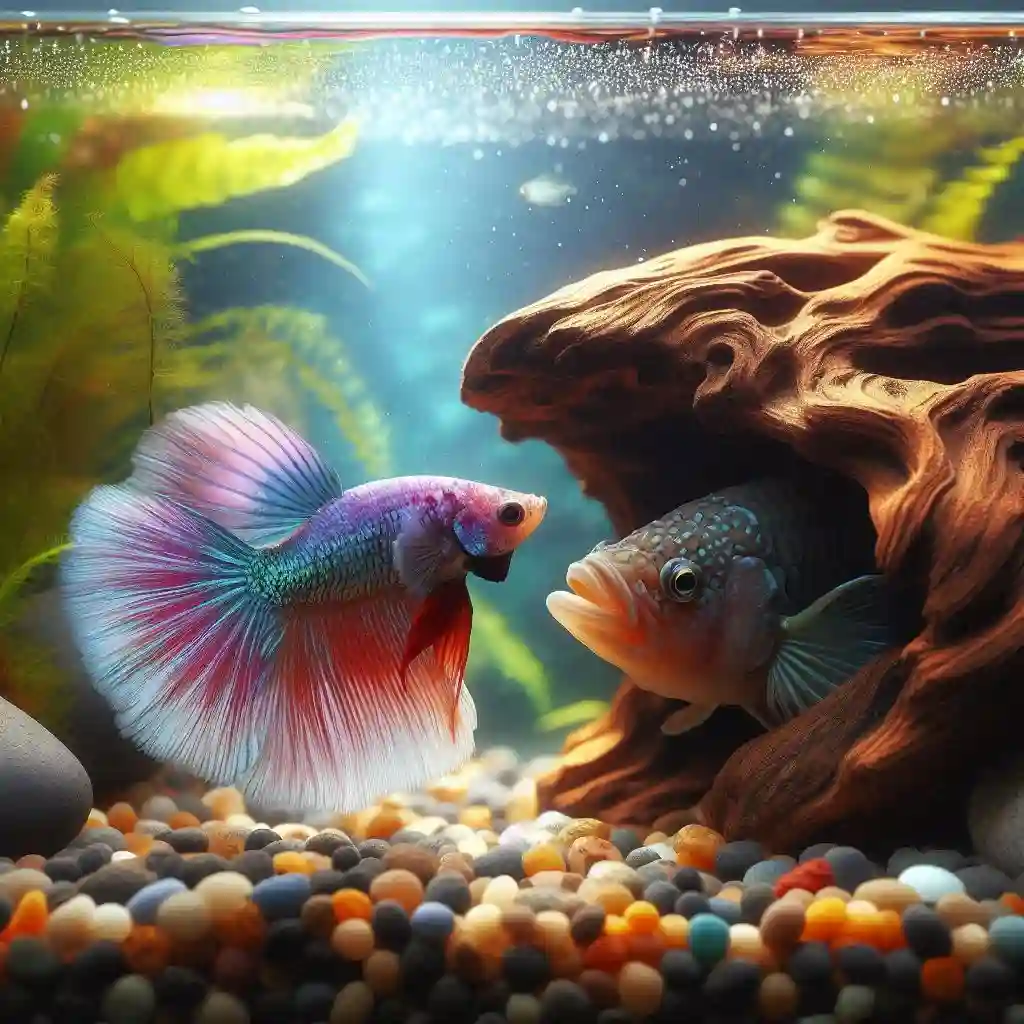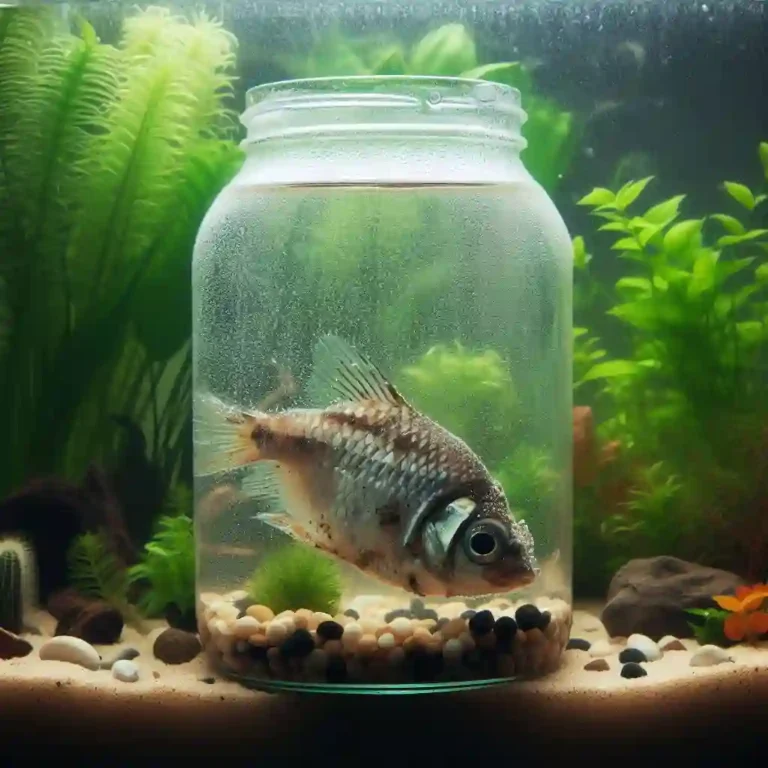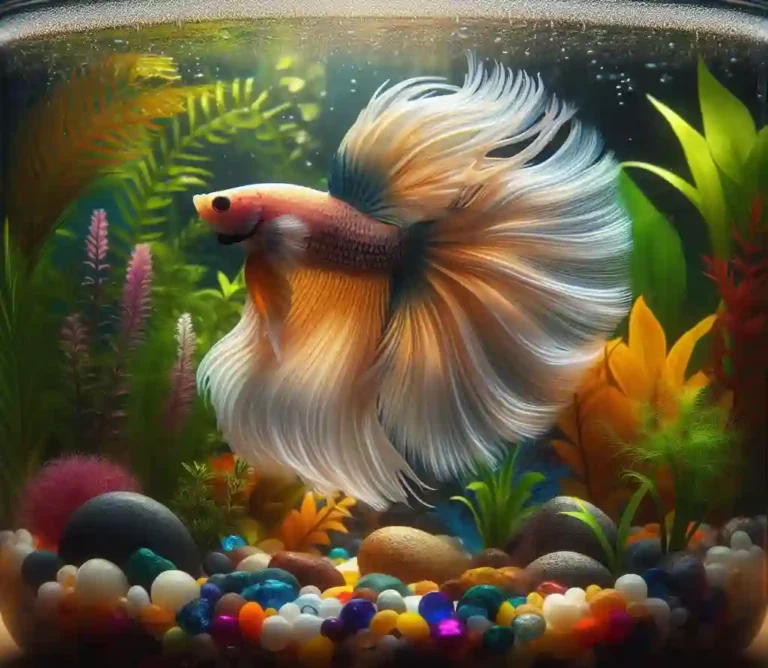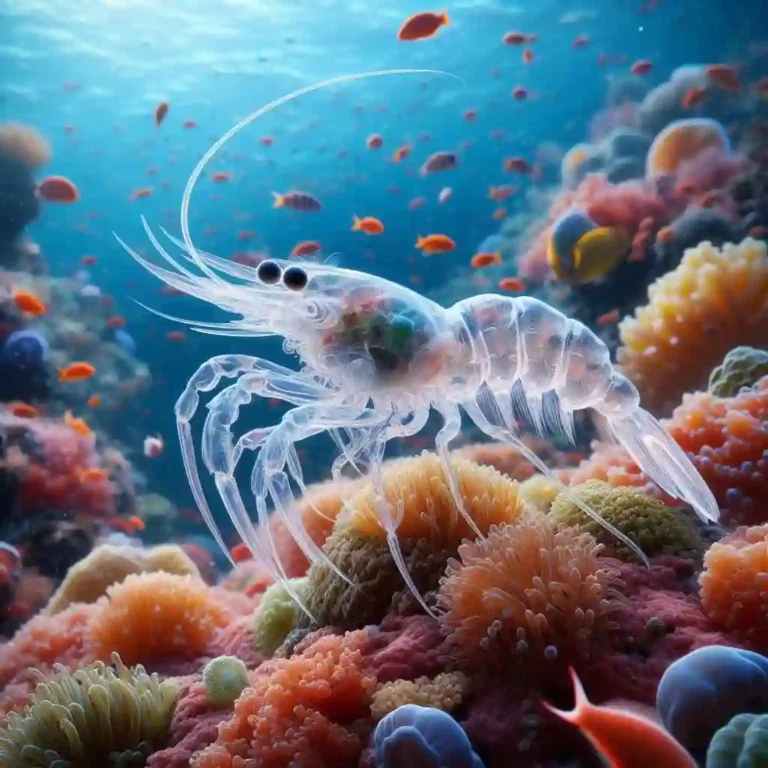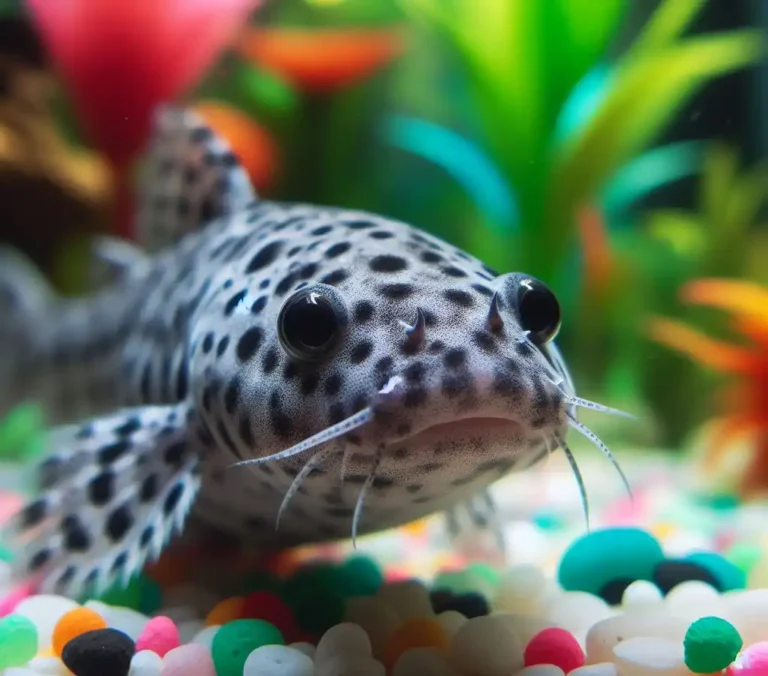Can Pleco and Betta Coexist? Understanding Their Needs and Habits
Can Pleco and Betta Coexist? Are you considering keeping both Plecos and Bettas in the same tank? While it may seem like a great idea to have two fascinating species living together in harmony, it’s essential to consider the potential challenges and risks involved.
In this blog, we’ll explore the pros and cons of keeping Plecos and Bettas together, and provide some valuable insights to help you make an informed decision.
So, let’s dive in and explore the possibilities and pitfalls of cohabiting Plecos and Bettas!
Can Pleco and Betta Coexist – A Quick Guide

Short Answer: No, it’s generally not recommended to keep Plecos and Bettas together in the same tank.
Reasons Why:
- Different Environmental Requirements: Plecos and Bettas have different environmental requirements, such as water temperature, pH, and water hardness.
- Competition for Food: Plecos and Bettas have different dietary needs and may compete for food.
- Aggression: Plecos can be aggressive towards Bettas, especially during mating or territorial disputes.
- Size and Space: Plecos can grow quite large, while Bettas are relatively small. This can lead to competition for space and resources.
Alternatives:
- Keep them separate: Keep Plecos and Bettas in separate tanks to ensure each species receives the care and environment it needs.
- Choose compatible tankmates: If you want to keep multiple fish together, choose species that are compatible with both Plecos and Bettas.
Understanding the Unique Needs of Plecos and Bettas
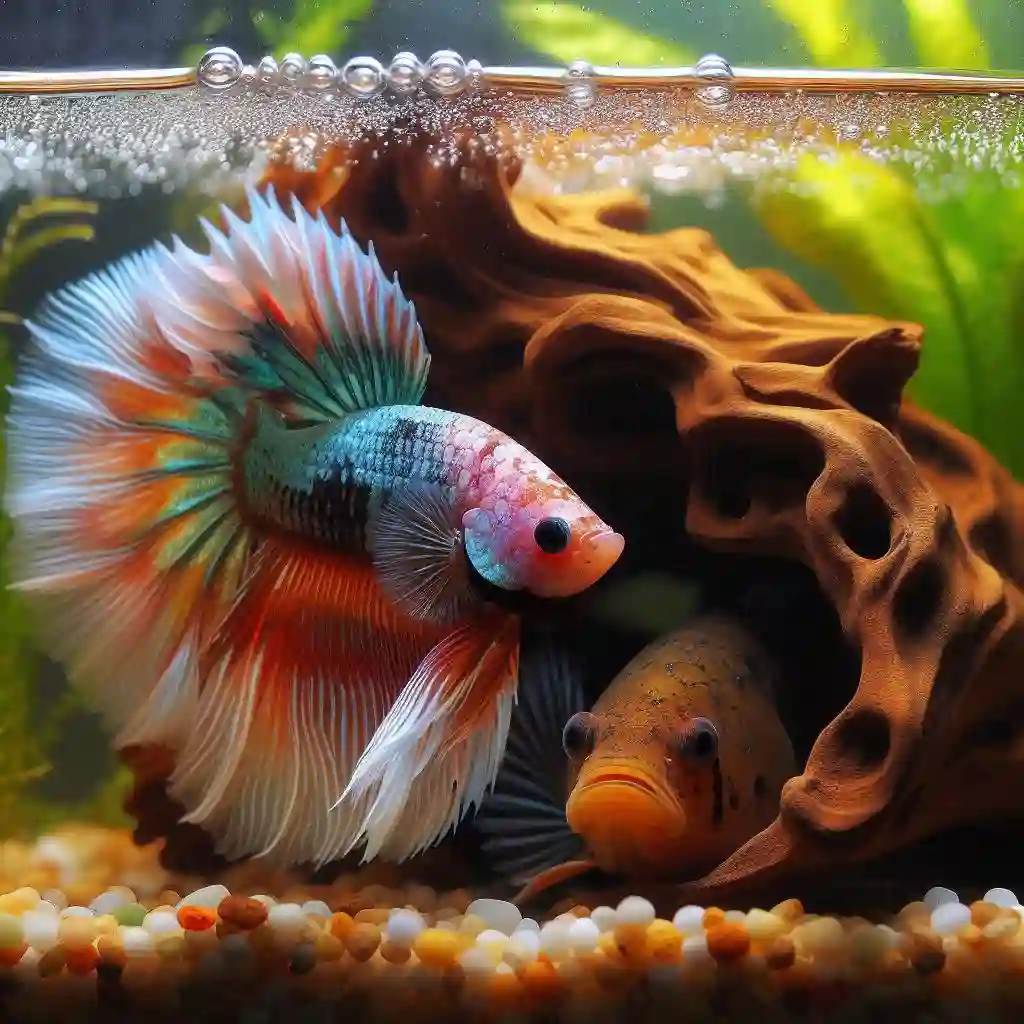
Pleco Needs:
- Space: Plecos are bottom-dwellers and need plenty of space to move around and forage for food. A minimum tank size of 20 gallons is recommended, with a secure lid to prevent escape.
- Diet: Plecos are herbivores and need a diet rich in plant matter. They love to eat algae, but also require a varied diet of vegetables and fruits.
- Hiding places: Plecos need plenty of hiding places, such as rocks, plants, and driftwood, to feel secure and reduce stress.
- Water parameters: Plecos prefer soft, slightly acidic water with a pH range of 6.5-7.5 and a temperature range of 72-82°F (22-28°C).
Betta Needs:
- Space: Bettas are solitary and prefer to have their own space. A minimum tank size of 5 gallons is recommended, with plenty of hiding places and visual barriers.
- Diet: Bettas are carnivores and need a diet rich in protein. They thrive on a varied diet of live or frozen foods, such as brine shrimp and bloodworms.
- Water movement: Bettas prefer slow-moving water with minimal currents, as they are not strong swimmers.
- Water parameters: Bettas prefer slightly acidic to neutral water with a pH range of 6.5-7.5 and a temperature range of 76-82°F (24-28°C).
The Pros and Cons of Keeping Plecos and Bettas Together
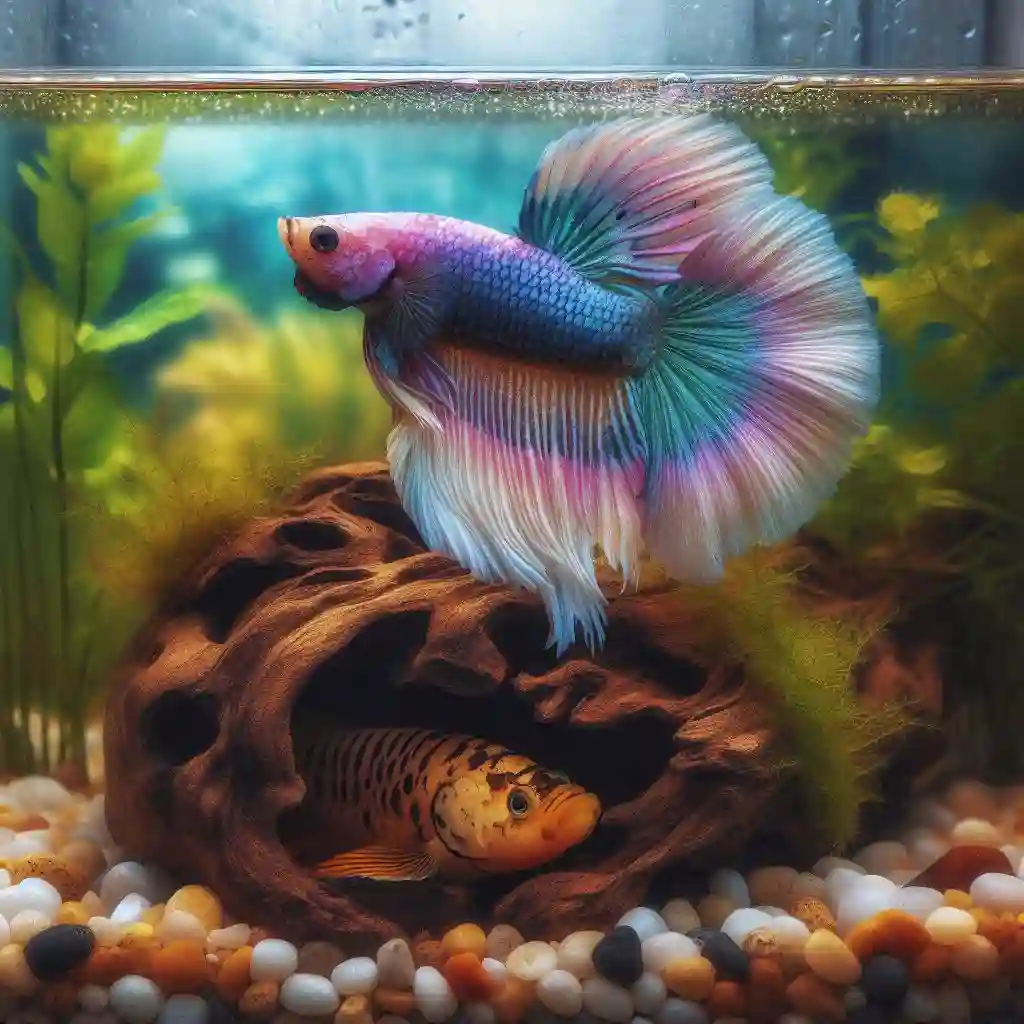
Pros:
- Diverse Aquascape: Plecos and Bettas have different habitat requirements, which can create a visually appealing and diverse aquascape.
- Mutual Benefit: Plecos can help clean up food debris, while Bettas can help control mosquito larvae populations.
- Interesting Behavior: Observing the unique behaviors and interactions between Plecos and Bettas can be fascinating and entertaining.
- Space Efficiency: Housing both species together can be a space-efficient option for aquarists with limited tank space.
- Cost-Effective: Keeping Plecos and Bettas together can be a cost-effective option, as you only need to maintain one tank.
Cons:
- Aggression: Bettas are known for their aggression, and may attack Plecos, especially during feeding or mating.
- Competition for Food: Plecos and Bettas have different feeding habits, which can lead to competition for food and potential malnutrition.
- Different Water Requirements: Plecos and Bettas have different water parameter requirements, which can make it challenging to create a suitable environment for both species.
- Hiding Place Competition: Both species require hiding places, which can lead to competition for these resources.
- Increased Maintenance: Housing two species together can increase maintenance tasks, such as water changes and tank cleaning.
Creating a Compatible Environment: Tank Size, Temperature, and Water Quality
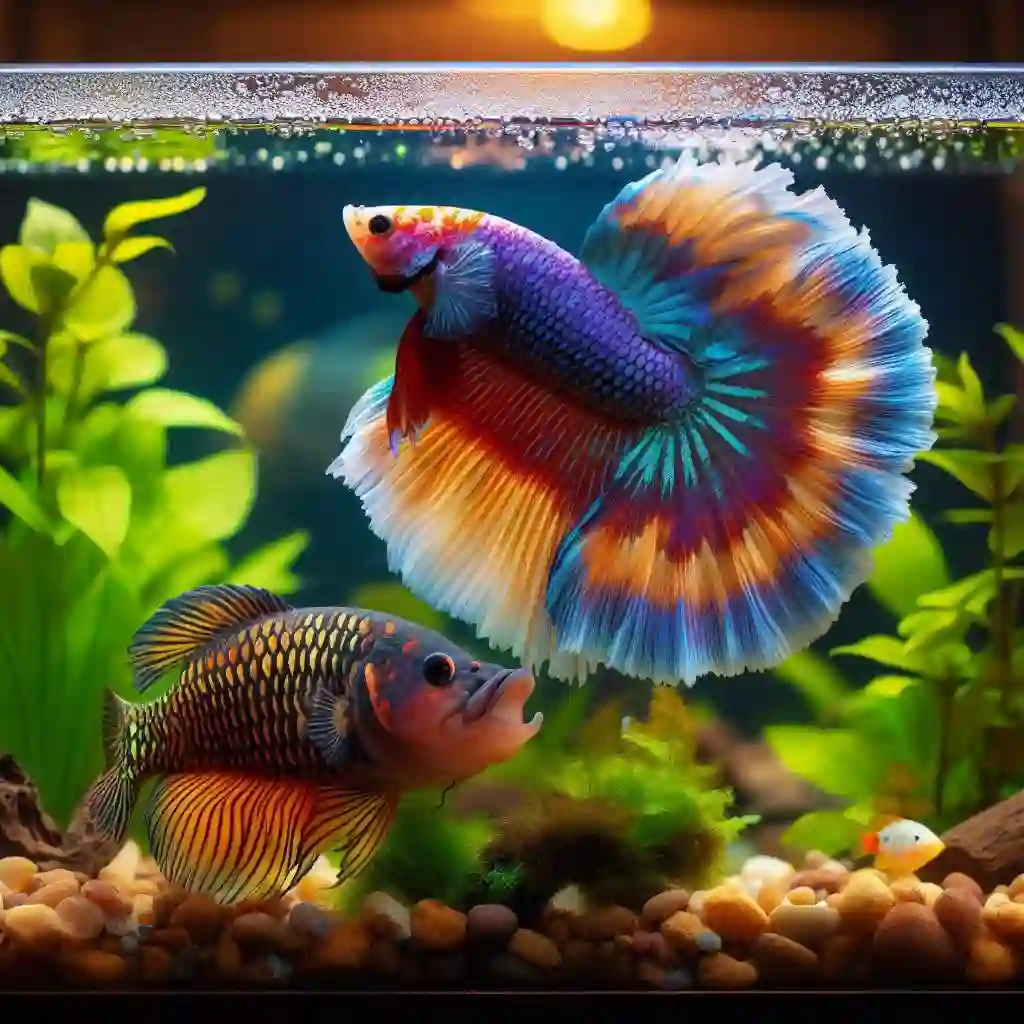
Tank Size:
- A minimum tank size of 20 gallons is recommended to provide ample space for both species.
- A longer tank (e.g., 30 inches long) is better than a taller tank (e.g., 20 inches tall) to provide more swimming space for the Betta.
- A secure lid is essential to prevent the Betta from jumping out of the tank.
Temperature:
- Plecos prefer a temperature range of 72-82°F (22-28°C), while Bettas prefer a range of 76-82°F (24-28°C).
- A temperature range of 76-80°F (24-27°C) is a good compromise for both species.
- Avoid sudden temperature changes, as this can stress both species.
Water Quality:
- Regular water changes (25-50% every 1-2 weeks) are crucial to maintain good water quality.
- Monitor water parameters, such as ammonia, nitrite, and nitrate levels, to ensure they are within safe ranges.
- Perform regular water tests to ensure the water is clean and safe for both species.
Water Parameters:
- pH: 6.5-7.5 (slightly acidic to neutral)
- Hardness: 5-10 dGH (moderate to hard water)
- Water movement: Gentle to moderate water movement is recommended to simulate the natural habitats of both species.
Decorations and Hiding Places:
- Provide plenty of hiding places, such as rocks, plants, and driftwood, to reduce stress and aggression.
- Include open swimming spaces for the Betta and plenty of substrate for the Pleco to dig and forage.
- Avoid sharp decorations that can cause injury to either species.
Pleco and Betta Diet: What to Feed Your Aquatic Friends
Pleco Diet:
- Herbivores: Plecos are herbivores and need a diet rich in plant matter.
- Algae: Plecos love to eat algae, so provide plenty of algae-rich foods, such as algae wafers or spirulina flakes.
- Vegetables: Offer a variety of vegetables, such as zucchini, carrots, and sweet potatoes, to provide essential nutrients.
- Fruits: Provide occasional treats of fruits, such as apples or berries, to add variety to their diet.
- Commercial foods: Use high-quality commercial Pleco foods, such as pellets or sticks, as a staple diet.
Betta Diet:
- Carnivores: Bettas are carnivores and need a diet rich in protein.
- Live or frozen foods: Offer live or frozen foods, such as brine shrimp, bloodworms, or daphnia, to provide essential protein.
- Commercial foods: Use high-quality commercial Betta foods, such as pellets or flakes, as a staple diet.
- Variety: Provide a varied diet, including foods like mosquito larvae, krill, or plankton, to ensure a balanced diet.
Feeding Tips:
- Feed separately: Feed Plecos and Bettas separately to ensure each species gets the nutrients they need.
- Avoid overfeeding: Only feed as much as your aquatic friends can consume within a few minutes to avoid water pollution.
- Rotate foods: Rotate foods regularly to ensure a varied diet and prevent boredom.
- Monitor health: Monitor your aquatic friends’ health and adjust their diet accordingly.
Supplements:
- Vitamins and minerals: Add vitamins and minerals to their diet, such as vitamin C or calcium, to ensure optimal health.
- Probiotics: Add probiotics to their diet to promote a healthy gut and immune system.
Behavioral Differences: Understanding Pleco and Betta Personalities
Pleco Personality:
- Laid-back: Plecos are generally laid-back and calm, preferring to spend their time foraging for food or resting.
- Solitary: Plecos are solitary animals and prefer to be alone, especially during feeding times.
- Nocturnal: Plecos are nocturnal, meaning they are most active at night, so be prepared for some nighttime activity.
- Territorial: Plecos can be territorial, especially during mating or feeding times, so provide plenty of hiding places and visual barriers.
Betta Personality:
- Aggressive: Bettas are known for their aggression, especially during mating or territorial disputes.
- Territorial: Bettas are extremely territorial and will defend their space from other fish, including Plecos.
- Active: Bettas are active swimmers and need plenty of space to exercise and play.
- Intelligent: Bettas are highly intelligent and can recognize their owners, so be prepared for some interactive play.
Behavioral Differences:
- Feeding behavior: Plecos are bottom-dwellers and feed on algae and plant matter, while Bettas are surface-dwellers and feed on protein-rich foods.
- Swimming patterns: Plecos are slow-moving and prefer to swim near the substrate, while Bettas are fast-moving and prefer to swim near the surface.
- Social behavior: Plecos are solitary and prefer to be alone, while Bettas are social and can be kept with other peaceful fish.
Tips for Introducing Plecos and Bettas to the Same Tank
1. Prepare the Tank:
- Ensure the tank is large enough to accommodate both species comfortably (at least 20 gallons).
- Provide plenty of hiding places, such as rocks, plants, and driftwood, to reduce stress and aggression.
- Maintain good water quality and stability before introducing the fish.
2. Acclimate the Fish:
- Acclimate the Pleco and Betta separately to the tank water conditions before introducing them to the same tank.
- Use a quarantine tank or a separate container to acclimate the fish for at least 2-3 weeks before introducing them to the main tank.
3. Introduce the Pleco First:
- Introduce the Pleco to the tank first, allowing it to establish its territory and get accustomed to the tank environment.
- Monitor the Pleco’s behavior and ensure it is comfortable and stress-free before introducing the Betta.
4. Introduce the Betta:
- Introduce the Betta to the tank slowly and carefully, allowing it to explore its new environment.
- Monitor the Betta’s behavior and ensure it is not aggressive or stressed.
5. Monitor Behavior:
- Observe the behavior of both species closely, looking for signs of aggression, stress, or territorial behavior.
- Be prepared to separate the fish if you notice any signs of aggression or stress.
6. Provide Plenty of Hiding Places:
- Provide plenty of hiding places, such as plants, rocks, and driftwood, to reduce stress and aggression.
- Ensure the hiding places are secure and cannot be easily disturbed by the other fish.
7. Maintain Good Water Quality:
- Regularly test the water quality and make adjustments as necessary to maintain a healthy environment for both species.
- Perform regular water changes (25-50% every 1-2 weeks) to maintain good water quality.
Common Health Issues in Plecos and Bettas: Prevention and Treatment
Pleco Health Issues:
- Ich: Caused by the parasite Ichthyophthirius multifiliis, ich can cause white spots on the Pleco’s body.
- Prevention: Maintain good water quality, avoid overcrowding, and provide a balanced diet.
- Treatment: Use ich medication, increase water temperature, and perform water changes.
- Fin rot: Caused by bacterial infections, fin rot can cause damage to the Pleco’s fins.
- Prevention: Maintain good water quality, avoid overcrowding, and provide a balanced diet.
- Treatment: Use antibiotics, improve water quality, and provide a balanced diet.
- Intestinal parasites: Caused by internal parasites, intestinal parasites can cause digestive issues in Plecos.
- Prevention: Provide a balanced diet, avoid overfeeding, and maintain good water quality.
- Treatment: Use anti-parasitic medication, improve water quality, and provide a balanced diet.
Betta Health Issues:
- Velvet disease: Caused by the parasite Oodinium, velvet disease can cause a golden dust-like coating on the Betta’s body.
- Prevention: Maintain good water quality, avoid overcrowding, and provide a balanced diet.
- Treatment: Use copper-based medication, increase water temperature, and perform water changes.
- Fin nipping: Caused by fin nipping, fin damage can occur in Bettas.
- Prevention: Provide plenty of hiding places, avoid overcrowding, and provide a balanced diet.
- Treatment: Use fin repair medication, improve water quality, and provide a balanced diet.
- Bloat: Caused by digestive issues, bloat can cause swelling in the Betta’s abdomen.
- Prevention: Provide a balanced diet, avoid overfeeding, and maintain good water quality.
- Treatment: Use bloat medication, improve water quality, and provide a balanced diet.
General Prevention and Treatment:
- Maintain good water quality by performing regular water changes and monitoring water parameters.
- Provide a balanced diet that meets the nutritional needs of both Plecos and Bettas.
- Avoid overcrowding and provide plenty of hiding places to reduce stress.
- Monitor the health of your fish regularly and seek professional advice if you notice any signs of illness.
Breeding and Lifespan: What to Expect from Your Pleco and Betta
Pleco Breeding:
- Mating: Plecos are hermaphroditic, meaning they have both male and female reproductive organs.
- Egg-laying: Female Plecos can lay up to 200 eggs at a time, which will hatch after 2-3 weeks.
- Fry care: Fry (baby Plecos) are vulnerable to predators and require careful care. Feed them small, live foods like brine shrimp or daphnia.
- Lifespan: Plecos can live up to 10-15 years in captivity, but their lifespan can vary depending on factors like diet, environment, and health.
Betta Breeding:
- Mating: Bettas are polygynous, meaning they can mate with multiple females.
- Egg-laying: Female Bettas can lay up to 100 eggs at a time, which will hatch after 2-3 days.
- Fry care: Fry (baby Bettas) are sensitive to water quality and require careful care. Feed them small, live foods like brine shrimp or daphnia.
- Lifespan: Bettas can live up to 3-5 years in captivity, but their lifespan can vary depending on factors like diet, environment, and health.
Tips for Breeding:
- Provide a suitable environment: Ensure the breeding tank is large enough, with plenty of hiding places and a secure lid to prevent jumping.
- Maintain good water quality: Regularly test the water quality and make adjustments as necessary to maintain a healthy environment.
- Monitor the fish: Observe the fish closely for signs of stress, disease, or aggression.
- Be patient: Breeding can be a time-consuming and challenging process. Be prepared to spend time and effort to ensure a successful breeding.
Tips for Caring for Fry:
- Provide a suitable environment: Ensure the fry tank is large enough, with plenty of hiding places and a secure lid to prevent jumping.
- Maintain good water quality: Regularly test the water quality and make adjustments as necessary to maintain a healthy environment.
- Feed the fry: Feed the fry small, live foods like brine shrimp or daphnia.
- Monitor the fry: Observe the fry closely for signs of stress, disease, or aggression.
FAQs
Q: Can Plecos and Bettas coexist in the same tank?
A: While it’s technically possible to keep Plecos and Bettas in the same tank, it’s not always recommended. Plecos are bottom-dwellers and Bettas are surface-dwellers, so they have different environmental and dietary requirements. Additionally, Plecos can be quite large and may compete with Bettas for food and space.
Q: What are some potential issues with keeping Plecos and Bettas together?
A: Some potential issues that may arise when keeping Plecos and Bettas together include:
- Competition for food and space
- Aggression between the two species
- Different water quality requirements
- Potential for the Pleco to eat the Betta’s food
Q: Are there any exceptions to the rule?
A: While it’s generally not recommended to keep Plecos and Bettas together, there are some exceptions. For example:
- If you have a very large tank (at least 55 gallons) with plenty of hiding places and visual barriers, you may be able to keep a small Pleco and a Betta together.
- If you have a very peaceful and calm Pleco, you may be able to keep it with a Betta. However, this is still not recommended and requires careful monitoring.
Q: How can I ensure the health and well-being of my fish if I do decide to keep them together?
A: If you do decide to keep Plecos and Bettas together, make sure to:
- Provide a large enough tank with plenty of hiding places and visual barriers
- Ensure the water quality is good and stable
- Monitor the behavior of both species closely for signs of aggression or stress
- Provide a varied and balanced diet for both species
- Avoid overcrowding and ensure there is enough space for both species to thrive
Q: What are some alternatives to keeping Plecos and Bettas together?
A: If you’re interested in keeping both Plecos and Bettas, you may want to consider keeping them in separate tanks. This will allow you to provide each species with the specific environment and care it needs to thrive.

Hello, I’m Aria Cooper, the heart and soul behind Swimmy Buddies. As a devoted fish aficionado, I share my aquatic adventures and expertise to inspire your own underwater explorations. 🐠🌊

